CHCECE004: Promote and Provide Healthy Food and Drinks Assessment
VerifiedAdded on 2023/03/30
|23
|3500
|267
Homework Assignment
AI Summary
This document provides comprehensive solutions to the CHCECE004 assessment on promoting and providing healthy food and drinks in childcare settings. The assessment includes various components such as short questions, case studies, and research activities. The short questions cover topics like food safety standards, labeling and storage of bottles, and the National Quality Standard (NQS) 2.2.1. Case studies and research activities delve into topics like dietary fats for infants, introducing solids, matching food types to age groups, and the five food groups. Additionally, the assignment explores menu planning, daily nutritional requirements, safe food practices, water intake, and addressing childhood obesity. Educators' roles in fostering healthy attitudes towards food, implementing hygiene practices, and minimizing health risks are also discussed.
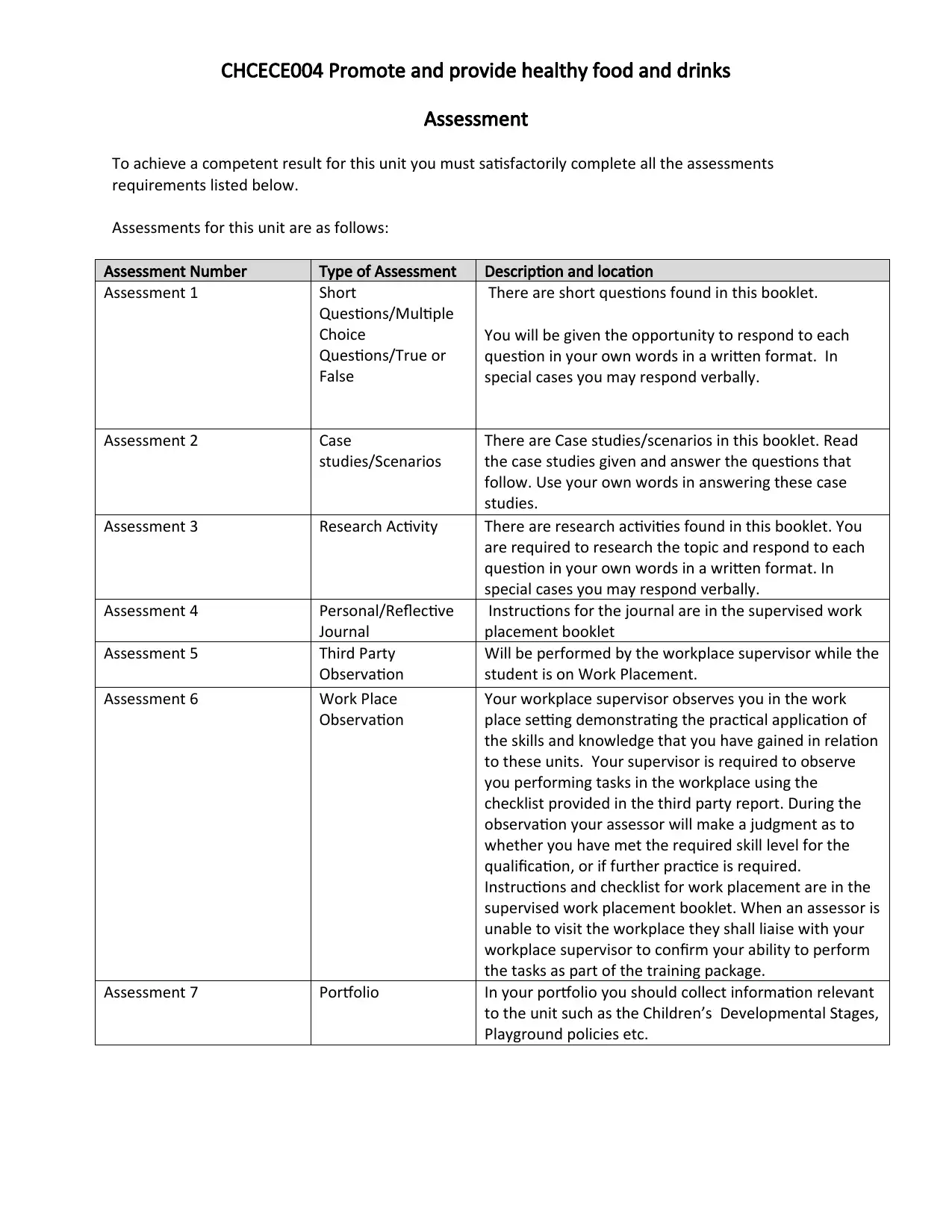
CHCECE004 Promote and provide healthy food and drinks
Assessment
To achieve a competent result for this unit you must satisfactorily complete all the assessments
requirements listed below.
Assessments for this unit are as follows:
Assessment Number Type of Assessment Description and location
Assessment 1 Short
Questions/Multiple
Choice
Questions/True or
False
There are short questions found in this booklet.
You will be given the opportunity to respond to each
question in your own words in a written format. In
special cases you may respond verbally.
Assessment 2 Case
studies/Scenarios
There are Case studies/scenarios in this booklet. Read
the case studies given and answer the questions that
follow. Use your own words in answering these case
studies.
Assessment 3 Research Activity There are research activities found in this booklet. You
are required to research the topic and respond to each
question in your own words in a written format. In
special cases you may respond verbally.
Assessment 4 Personal/Reflective
Journal
Instructions for the journal are in the supervised work
placement booklet
Assessment 5 Third Party
Observation
Will be performed by the workplace supervisor while the
student is on Work Placement.
Assessment 6 Work Place
Observation
Your workplace supervisor observes you in the work
place setting demonstrating the practical application of
the skills and knowledge that you have gained in relation
to these units. Your supervisor is required to observe
you performing tasks in the workplace using the
checklist provided in the third party report. During the
observation your assessor will make a judgment as to
whether you have met the required skill level for the
qualification, or if further practice is required.
Instructions and checklist for work placement are in the
supervised work placement booklet. When an assessor is
unable to visit the workplace they shall liaise with your
workplace supervisor to confirm your ability to perform
the tasks as part of the training package.
Assessment 7 Portfolio In your portfolio you should collect information relevant
to the unit such as the Children’s Developmental Stages,
Playground policies etc.
Assessment
To achieve a competent result for this unit you must satisfactorily complete all the assessments
requirements listed below.
Assessments for this unit are as follows:
Assessment Number Type of Assessment Description and location
Assessment 1 Short
Questions/Multiple
Choice
Questions/True or
False
There are short questions found in this booklet.
You will be given the opportunity to respond to each
question in your own words in a written format. In
special cases you may respond verbally.
Assessment 2 Case
studies/Scenarios
There are Case studies/scenarios in this booklet. Read
the case studies given and answer the questions that
follow. Use your own words in answering these case
studies.
Assessment 3 Research Activity There are research activities found in this booklet. You
are required to research the topic and respond to each
question in your own words in a written format. In
special cases you may respond verbally.
Assessment 4 Personal/Reflective
Journal
Instructions for the journal are in the supervised work
placement booklet
Assessment 5 Third Party
Observation
Will be performed by the workplace supervisor while the
student is on Work Placement.
Assessment 6 Work Place
Observation
Your workplace supervisor observes you in the work
place setting demonstrating the practical application of
the skills and knowledge that you have gained in relation
to these units. Your supervisor is required to observe
you performing tasks in the workplace using the
checklist provided in the third party report. During the
observation your assessor will make a judgment as to
whether you have met the required skill level for the
qualification, or if further practice is required.
Instructions and checklist for work placement are in the
supervised work placement booklet. When an assessor is
unable to visit the workplace they shall liaise with your
workplace supervisor to confirm your ability to perform
the tasks as part of the training package.
Assessment 7 Portfolio In your portfolio you should collect information relevant
to the unit such as the Children’s Developmental Stages,
Playground policies etc.
Paraphrase This Document
Need a fresh take? Get an instant paraphrase of this document with our AI Paraphraser
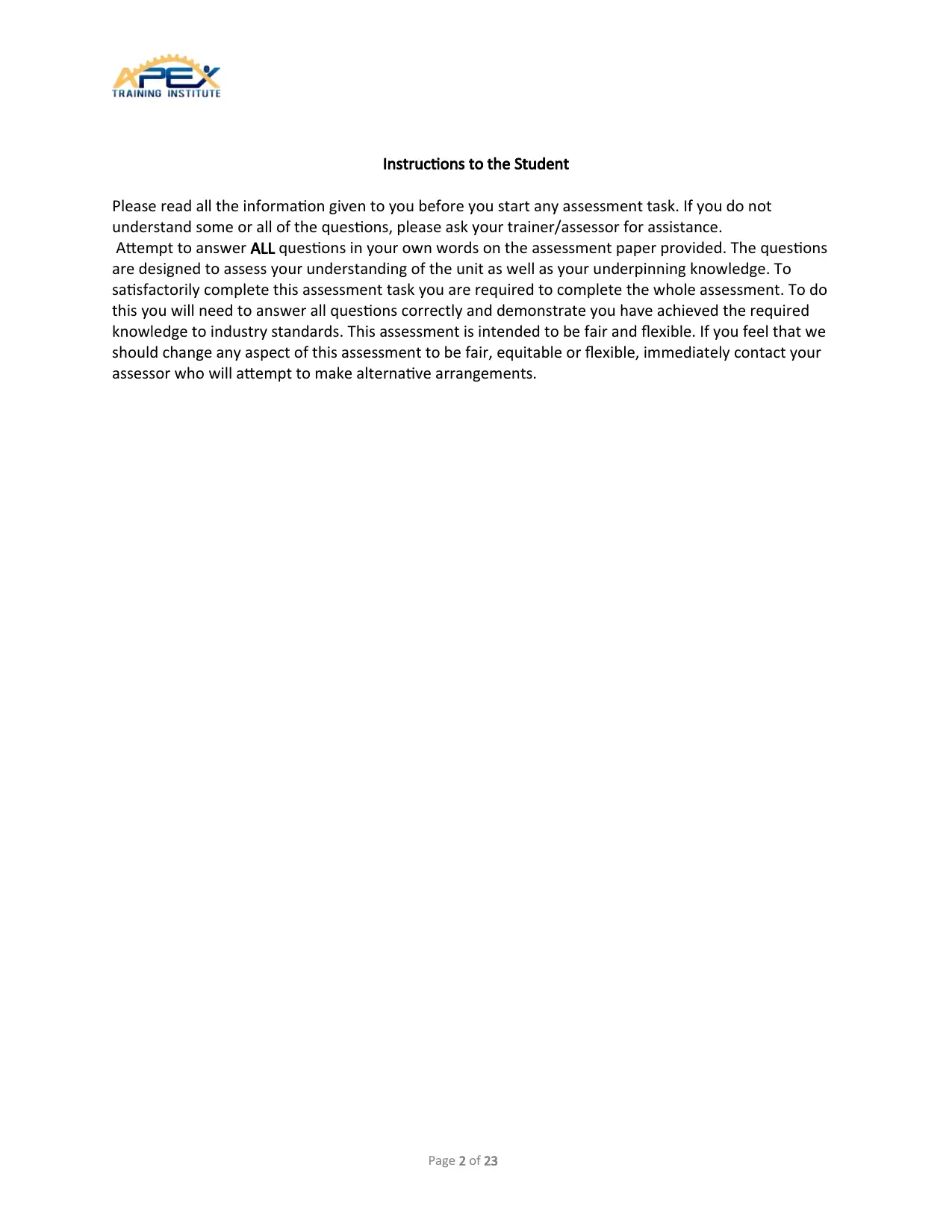
Instructions to the Student
Please read all the information given to you before you start any assessment task. If you do not
understand some or all of the questions, please ask your trainer/assessor for assistance.
Attempt to answer ALL questions in your own words on the assessment paper provided. The questions
are designed to assess your understanding of the unit as well as your underpinning knowledge. To
satisfactorily complete this assessment task you are required to complete the whole assessment. To do
this you will need to answer all questions correctly and demonstrate you have achieved the required
knowledge to industry standards. This assessment is intended to be fair and flexible. If you feel that we
should change any aspect of this assessment to be fair, equitable or flexible, immediately contact your
assessor who will attempt to make alternative arrangements.
Page 2 of 23
Please read all the information given to you before you start any assessment task. If you do not
understand some or all of the questions, please ask your trainer/assessor for assistance.
Attempt to answer ALL questions in your own words on the assessment paper provided. The questions
are designed to assess your understanding of the unit as well as your underpinning knowledge. To
satisfactorily complete this assessment task you are required to complete the whole assessment. To do
this you will need to answer all questions correctly and demonstrate you have achieved the required
knowledge to industry standards. This assessment is intended to be fair and flexible. If you feel that we
should change any aspect of this assessment to be fair, equitable or flexible, immediately contact your
assessor who will attempt to make alternative arrangements.
Page 2 of 23
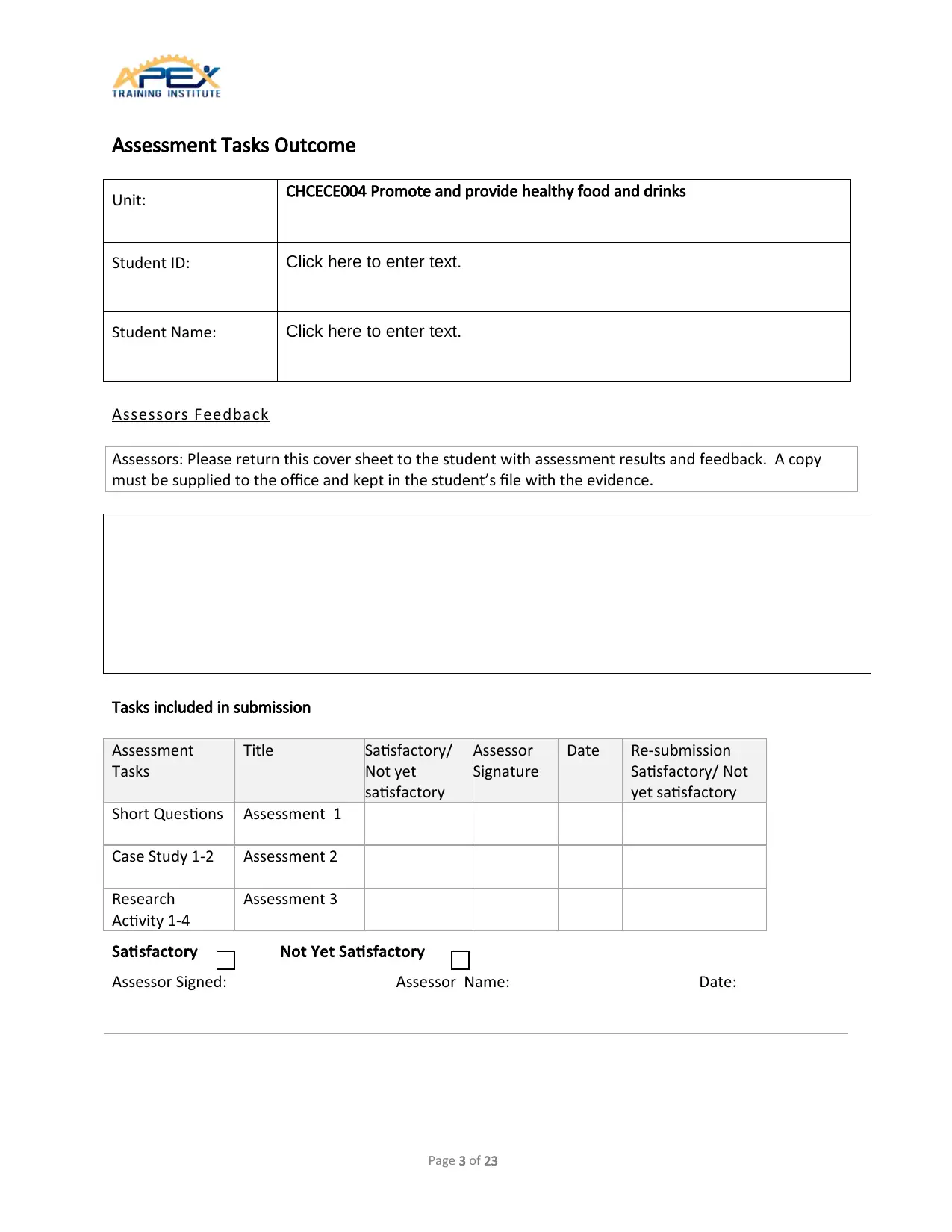
Assessment Tasks Outcome
Unit: CHCECE004 Promote and provide healthy food and drinks
Student ID: Click here to enter text.
Student Name: Click here to enter text.
Assessors Feedback
Assessors: Please return this cover sheet to the student with assessment results and feedback. A copy
must be supplied to the office and kept in the student’s file with the evidence.
Tasks included in submission
Assessment
Tasks
Title Satisfactory/
Not yet
satisfactory
Assessor
Signature
Date Re-submission
Satisfactory/ Not
yet satisfactory
Short Questions Assessment 1
Case Study 1-2 Assessment 2
Research
Activity 1-4
Assessment 3
Satisfactory Not Yet Satisfactory
Assessor Signed: Assessor Name: Date:
Page 3 of 23
Unit: CHCECE004 Promote and provide healthy food and drinks
Student ID: Click here to enter text.
Student Name: Click here to enter text.
Assessors Feedback
Assessors: Please return this cover sheet to the student with assessment results and feedback. A copy
must be supplied to the office and kept in the student’s file with the evidence.
Tasks included in submission
Assessment
Tasks
Title Satisfactory/
Not yet
satisfactory
Assessor
Signature
Date Re-submission
Satisfactory/ Not
yet satisfactory
Short Questions Assessment 1
Case Study 1-2 Assessment 2
Research
Activity 1-4
Assessment 3
Satisfactory Not Yet Satisfactory
Assessor Signed: Assessor Name: Date:
Page 3 of 23
⊘ This is a preview!⊘
Do you want full access?
Subscribe today to unlock all pages.

Trusted by 1+ million students worldwide

Page left intentionally blank
Page 4 of 23
Page 4 of 23
Paraphrase This Document
Need a fresh take? Get an instant paraphrase of this document with our AI Paraphraser
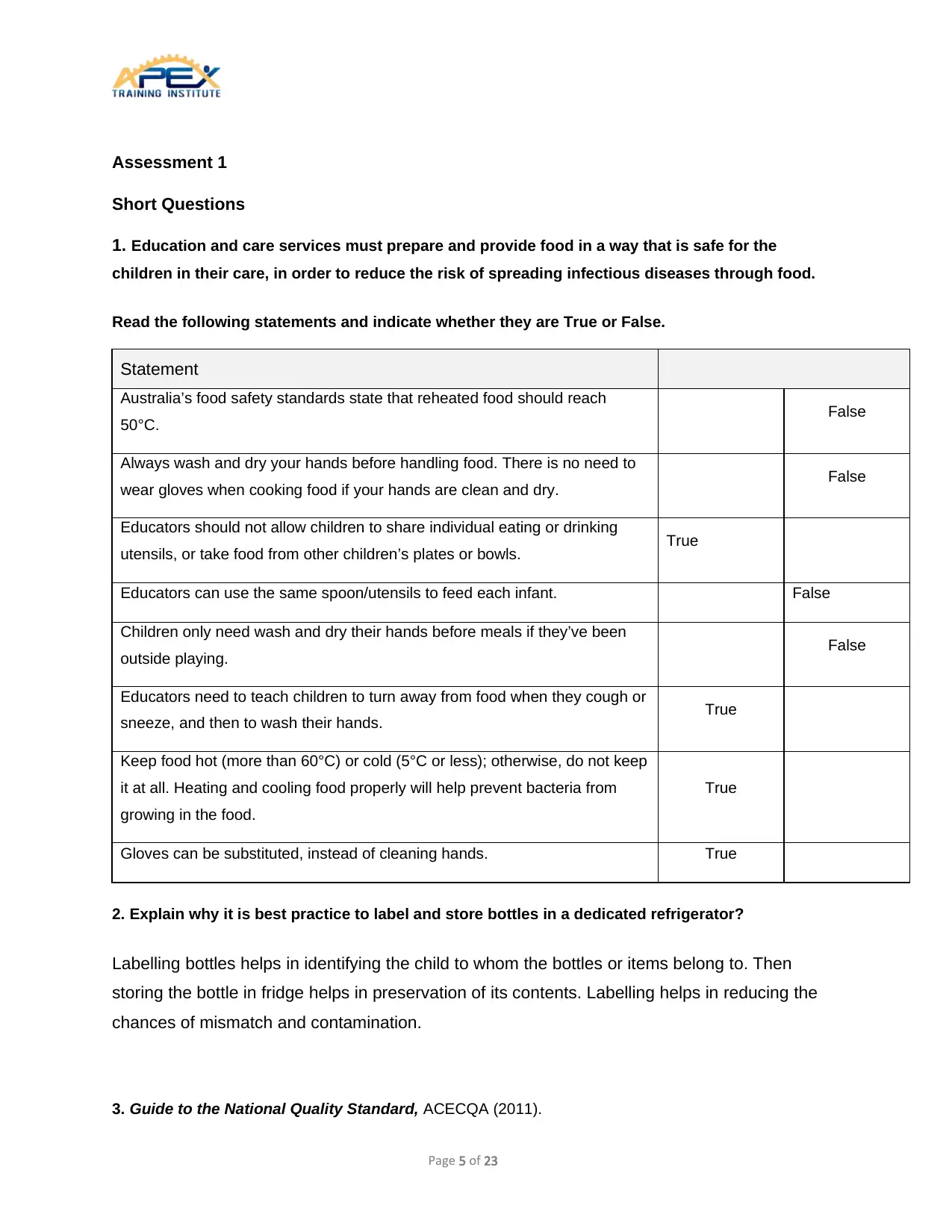
Assessment 1
Short Questions
1. Education and care services must prepare and provide food in a way that is safe for the
children in their care, in order to reduce the risk of spreading infectious diseases through food.
Read the following statements and indicate whether they are True or False.
Statement
Australia’s food safety standards state that reheated food should reach
50°C. False
Always wash and dry your hands before handling food. There is no need to
wear gloves when cooking food if your hands are clean and dry. False
Educators should not allow children to share individual eating or drinking
utensils, or take food from other children’s plates or bowls. True
Educators can use the same spoon/utensils to feed each infant. False
Children only need wash and dry their hands before meals if they’ve been
outside playing. False
Educators need to teach children to turn away from food when they cough or
sneeze, and then to wash their hands. True
Keep food hot (more than 60°C) or cold (5°C or less); otherwise, do not keep
it at all. Heating and cooling food properly will help prevent bacteria from
growing in the food.
True
Gloves can be substituted, instead of cleaning hands. True
2. Explain why it is best practice to label and store bottles in a dedicated refrigerator?
Labelling bottles helps in identifying the child to whom the bottles or items belong to. Then
storing the bottle in fridge helps in preservation of its contents. Labelling helps in reducing the
chances of mismatch and contamination.
3. Guide to the National Quality Standard, ACECQA (2011).
Page 5 of 23
Short Questions
1. Education and care services must prepare and provide food in a way that is safe for the
children in their care, in order to reduce the risk of spreading infectious diseases through food.
Read the following statements and indicate whether they are True or False.
Statement
Australia’s food safety standards state that reheated food should reach
50°C. False
Always wash and dry your hands before handling food. There is no need to
wear gloves when cooking food if your hands are clean and dry. False
Educators should not allow children to share individual eating or drinking
utensils, or take food from other children’s plates or bowls. True
Educators can use the same spoon/utensils to feed each infant. False
Children only need wash and dry their hands before meals if they’ve been
outside playing. False
Educators need to teach children to turn away from food when they cough or
sneeze, and then to wash their hands. True
Keep food hot (more than 60°C) or cold (5°C or less); otherwise, do not keep
it at all. Heating and cooling food properly will help prevent bacteria from
growing in the food.
True
Gloves can be substituted, instead of cleaning hands. True
2. Explain why it is best practice to label and store bottles in a dedicated refrigerator?
Labelling bottles helps in identifying the child to whom the bottles or items belong to. Then
storing the bottle in fridge helps in preservation of its contents. Labelling helps in reducing the
chances of mismatch and contamination.
3. Guide to the National Quality Standard, ACECQA (2011).
Page 5 of 23
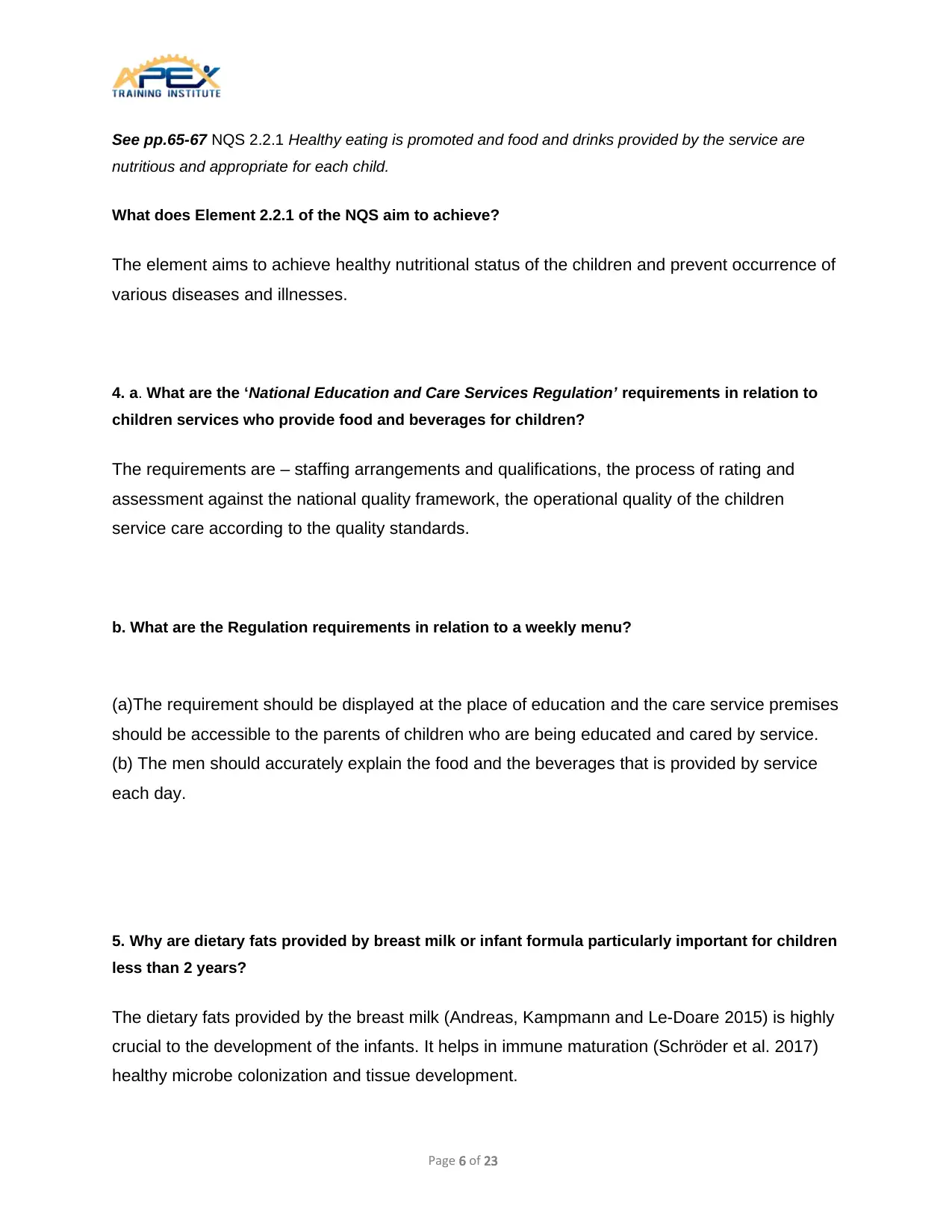
See pp.65-67 NQS 2.2.1 Healthy eating is promoted and food and drinks provided by the service are
nutritious and appropriate for each child.
What does Element 2.2.1 of the NQS aim to achieve?
The element aims to achieve healthy nutritional status of the children and prevent occurrence of
various diseases and illnesses.
4. a. What are the ‘National Education and Care Services Regulation’ requirements in relation to
children services who provide food and beverages for children?
The requirements are – staffing arrangements and qualifications, the process of rating and
assessment against the national quality framework, the operational quality of the children
service care according to the quality standards.
b. What are the Regulation requirements in relation to a weekly menu?
(a)The requirement should be displayed at the place of education and the care service premises
should be accessible to the parents of children who are being educated and cared by service.
(b) The men should accurately explain the food and the beverages that is provided by service
each day.
5. Why are dietary fats provided by breast milk or infant formula particularly important for children
less than 2 years?
The dietary fats provided by the breast milk (Andreas, Kampmann and Le-Doare 2015) is highly
crucial to the development of the infants. It helps in immune maturation (Schröder et al. 2017)
healthy microbe colonization and tissue development.
Page 6 of 23
nutritious and appropriate for each child.
What does Element 2.2.1 of the NQS aim to achieve?
The element aims to achieve healthy nutritional status of the children and prevent occurrence of
various diseases and illnesses.
4. a. What are the ‘National Education and Care Services Regulation’ requirements in relation to
children services who provide food and beverages for children?
The requirements are – staffing arrangements and qualifications, the process of rating and
assessment against the national quality framework, the operational quality of the children
service care according to the quality standards.
b. What are the Regulation requirements in relation to a weekly menu?
(a)The requirement should be displayed at the place of education and the care service premises
should be accessible to the parents of children who are being educated and cared by service.
(b) The men should accurately explain the food and the beverages that is provided by service
each day.
5. Why are dietary fats provided by breast milk or infant formula particularly important for children
less than 2 years?
The dietary fats provided by the breast milk (Andreas, Kampmann and Le-Doare 2015) is highly
crucial to the development of the infants. It helps in immune maturation (Schröder et al. 2017)
healthy microbe colonization and tissue development.
Page 6 of 23
⊘ This is a preview!⊘
Do you want full access?
Subscribe today to unlock all pages.

Trusted by 1+ million students worldwide

6. In the first few months, all of the babies’ nutritional requirements are provided through either
Breast milk or formula. Later, babies need solid foods in addition to breast milk or formula for
adequate nutrients and energy.
a. When should solids be introduced to babies?
Rice cereals, mashed potatoes, cottage cheese are good choices and to be introduced from 4
to 6 months.
b. How should solids be introduced to babies?
Solid should not be fed from a jar, stirring and warming the purees. It should meet the
requirement of formula and must be checked from allergies.
7. Match the types of foods and consistency to the following age groups.
Birth – around 6 months 8 - 12 months 12 months +
Age Types of food and
consistency
Examples of foods that can be consumed
8 -12 months Mashed or chopped
foods and finger foods
(no salt, sugar, fat or
other flavours added)
Breast milk.
Infant formula (if partially or no longer breast feeding).
Infant cereals.
Well-cooked and mashed or minced fish, minced liver
and minced or finely shredded meat, chicken and egg.
Variety or mashed or soft cooked vegetables, including
beans lentils and broccoli.
Mashed and cooked fruit.
Chopped soft raw fruit such as melon and banana.
Cereals such as rice, wheat, oats, bread, pasta and
noddles.
Cheese, custards, yoghurt
8-12 months Family Foods Breast milk and/or plain pasteurised full cream milk.
Variety of foods from all food groups, with varying
Page 7 of 23
Breast milk or formula. Later, babies need solid foods in addition to breast milk or formula for
adequate nutrients and energy.
a. When should solids be introduced to babies?
Rice cereals, mashed potatoes, cottage cheese are good choices and to be introduced from 4
to 6 months.
b. How should solids be introduced to babies?
Solid should not be fed from a jar, stirring and warming the purees. It should meet the
requirement of formula and must be checked from allergies.
7. Match the types of foods and consistency to the following age groups.
Birth – around 6 months 8 - 12 months 12 months +
Age Types of food and
consistency
Examples of foods that can be consumed
8 -12 months Mashed or chopped
foods and finger foods
(no salt, sugar, fat or
other flavours added)
Breast milk.
Infant formula (if partially or no longer breast feeding).
Infant cereals.
Well-cooked and mashed or minced fish, minced liver
and minced or finely shredded meat, chicken and egg.
Variety or mashed or soft cooked vegetables, including
beans lentils and broccoli.
Mashed and cooked fruit.
Chopped soft raw fruit such as melon and banana.
Cereals such as rice, wheat, oats, bread, pasta and
noddles.
Cheese, custards, yoghurt
8-12 months Family Foods Breast milk and/or plain pasteurised full cream milk.
Variety of foods from all food groups, with varying
Page 7 of 23
Paraphrase This Document
Need a fresh take? Get an instant paraphrase of this document with our AI Paraphraser
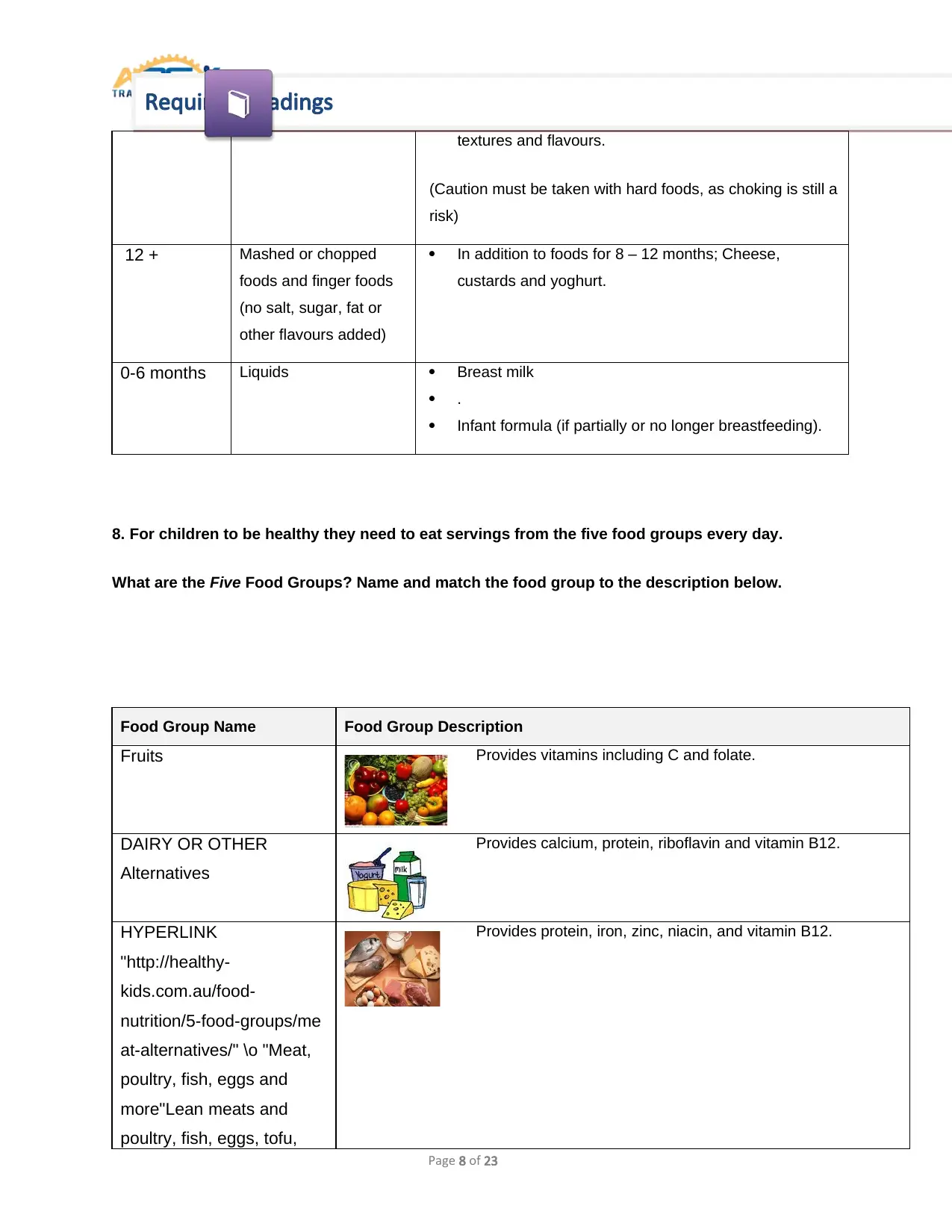
textures and flavours.
(Caution must be taken with hard foods, as choking is still a
risk)
12 + Mashed or chopped
foods and finger foods
(no salt, sugar, fat or
other flavours added)
In addition to foods for 8 – 12 months; Cheese,
custards and yoghurt.
0-6 months Liquids Breast milk
.
Infant formula (if partially or no longer breastfeeding).
8. For children to be healthy they need to eat servings from the five food groups every day.
What are the Five Food Groups? Name and match the food group to the description below.
Food Group Name Food Group Description
Fruits Provides vitamins including C and folate.
DAIRY OR OTHER
Alternatives
Provides calcium, protein, riboflavin and vitamin B12.
HYPERLINK
"http://healthy-
kids.com.au/food-
nutrition/5-food-groups/me
at-alternatives/" \o "Meat,
poultry, fish, eggs and
more"Lean meats and
poultry, fish, eggs, tofu,
Provides protein, iron, zinc, niacin, and vitamin B12.
Page 8 of 23
Required Readings
(Caution must be taken with hard foods, as choking is still a
risk)
12 + Mashed or chopped
foods and finger foods
(no salt, sugar, fat or
other flavours added)
In addition to foods for 8 – 12 months; Cheese,
custards and yoghurt.
0-6 months Liquids Breast milk
.
Infant formula (if partially or no longer breastfeeding).
8. For children to be healthy they need to eat servings from the five food groups every day.
What are the Five Food Groups? Name and match the food group to the description below.
Food Group Name Food Group Description
Fruits Provides vitamins including C and folate.
DAIRY OR OTHER
Alternatives
Provides calcium, protein, riboflavin and vitamin B12.
HYPERLINK
"http://healthy-
kids.com.au/food-
nutrition/5-food-groups/me
at-alternatives/" \o "Meat,
poultry, fish, eggs and
more"Lean meats and
poultry, fish, eggs, tofu,
Provides protein, iron, zinc, niacin, and vitamin B12.
Page 8 of 23
Required Readings
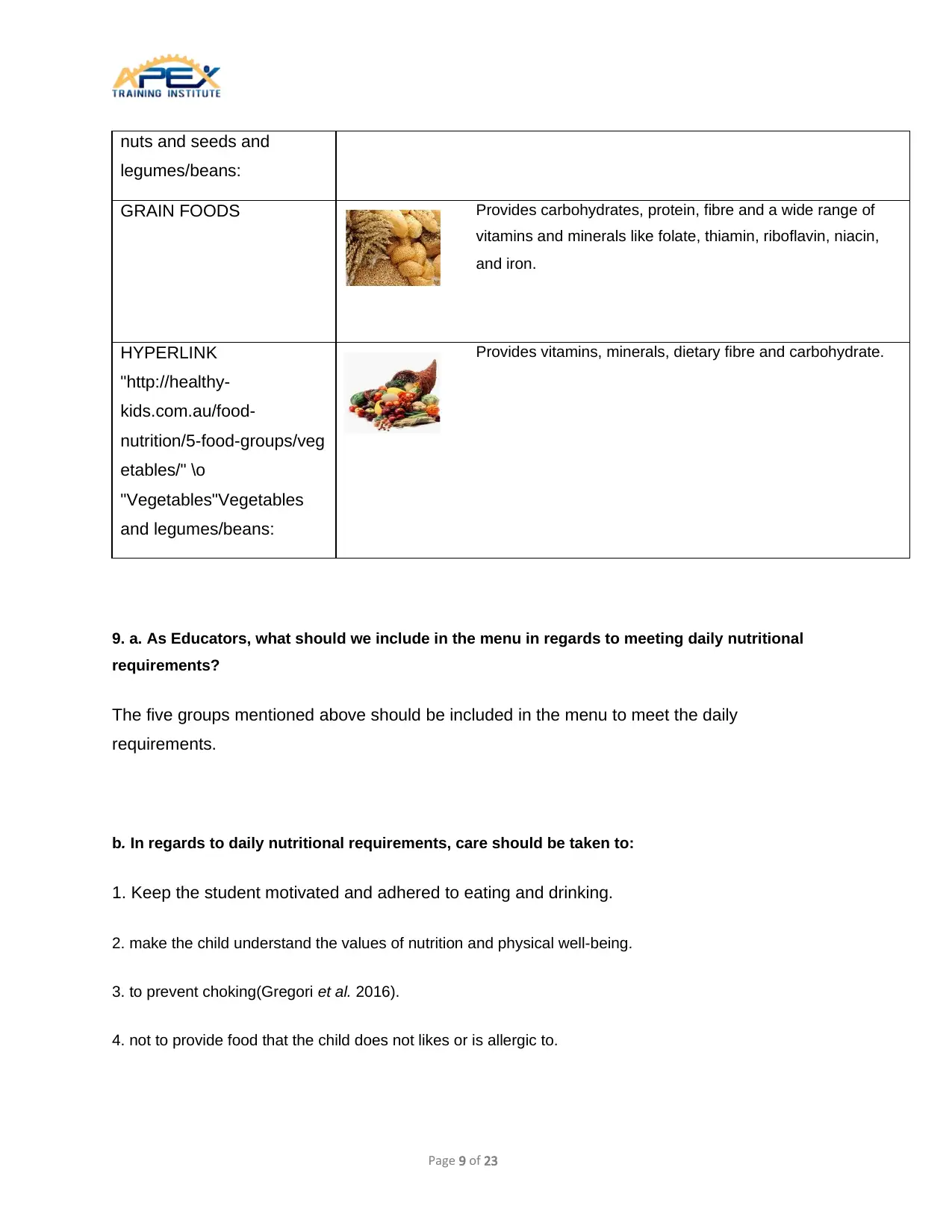
nuts and seeds and
legumes/beans:
GRAIN FOODS Provides carbohydrates, protein, fibre and a wide range of
vitamins and minerals like folate, thiamin, riboflavin, niacin,
and iron.
HYPERLINK
"http://healthy-
kids.com.au/food-
nutrition/5-food-groups/veg
etables/" \o
"Vegetables"Vegetables
and legumes/beans:
Provides vitamins, minerals, dietary fibre and carbohydrate.
9. a. As Educators, what should we include in the menu in regards to meeting daily nutritional
requirements?
The five groups mentioned above should be included in the menu to meet the daily
requirements.
b. In regards to daily nutritional requirements, care should be taken to:
1. Keep the student motivated and adhered to eating and drinking.
2. make the child understand the values of nutrition and physical well-being.
3. to prevent choking(Gregori et al. 2016).
4. not to provide food that the child does not likes or is allergic to.
Page 9 of 23
legumes/beans:
GRAIN FOODS Provides carbohydrates, protein, fibre and a wide range of
vitamins and minerals like folate, thiamin, riboflavin, niacin,
and iron.
HYPERLINK
"http://healthy-
kids.com.au/food-
nutrition/5-food-groups/veg
etables/" \o
"Vegetables"Vegetables
and legumes/beans:
Provides vitamins, minerals, dietary fibre and carbohydrate.
9. a. As Educators, what should we include in the menu in regards to meeting daily nutritional
requirements?
The five groups mentioned above should be included in the menu to meet the daily
requirements.
b. In regards to daily nutritional requirements, care should be taken to:
1. Keep the student motivated and adhered to eating and drinking.
2. make the child understand the values of nutrition and physical well-being.
3. to prevent choking(Gregori et al. 2016).
4. not to provide food that the child does not likes or is allergic to.
Page 9 of 23
⊘ This is a preview!⊘
Do you want full access?
Subscribe today to unlock all pages.

Trusted by 1+ million students worldwide
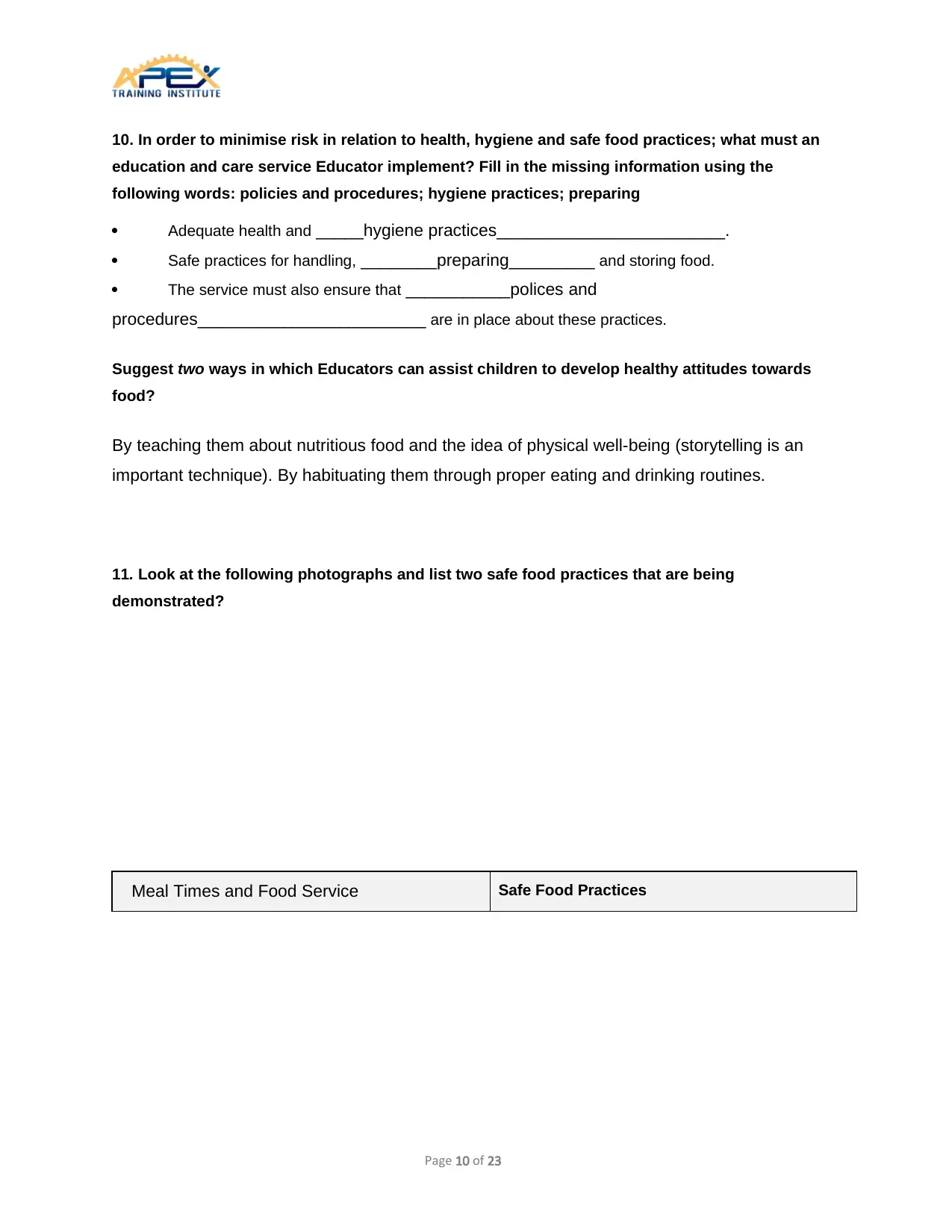
10. In order to minimise risk in relation to health, hygiene and safe food practices; what must an
education and care service Educator implement? Fill in the missing information using the
following words: policies and procedures; hygiene practices; preparing
Adequate health and _____hygiene practices________________________.
Safe practices for handling, ________preparing_________ and storing food.
The service must also ensure that ___________polices and
procedures________________________ are in place about these practices.
Suggest two ways in which Educators can assist children to develop healthy attitudes towards
food?
By teaching them about nutritious food and the idea of physical well-being (storytelling is an
important technique). By habituating them through proper eating and drinking routines.
11. Look at the following photographs and list two safe food practices that are being
demonstrated?
Meal Times and Food Service Safe Food Practices
Page 10 of 23
education and care service Educator implement? Fill in the missing information using the
following words: policies and procedures; hygiene practices; preparing
Adequate health and _____hygiene practices________________________.
Safe practices for handling, ________preparing_________ and storing food.
The service must also ensure that ___________polices and
procedures________________________ are in place about these practices.
Suggest two ways in which Educators can assist children to develop healthy attitudes towards
food?
By teaching them about nutritious food and the idea of physical well-being (storytelling is an
important technique). By habituating them through proper eating and drinking routines.
11. Look at the following photographs and list two safe food practices that are being
demonstrated?
Meal Times and Food Service Safe Food Practices
Page 10 of 23
Paraphrase This Document
Need a fresh take? Get an instant paraphrase of this document with our AI Paraphraser
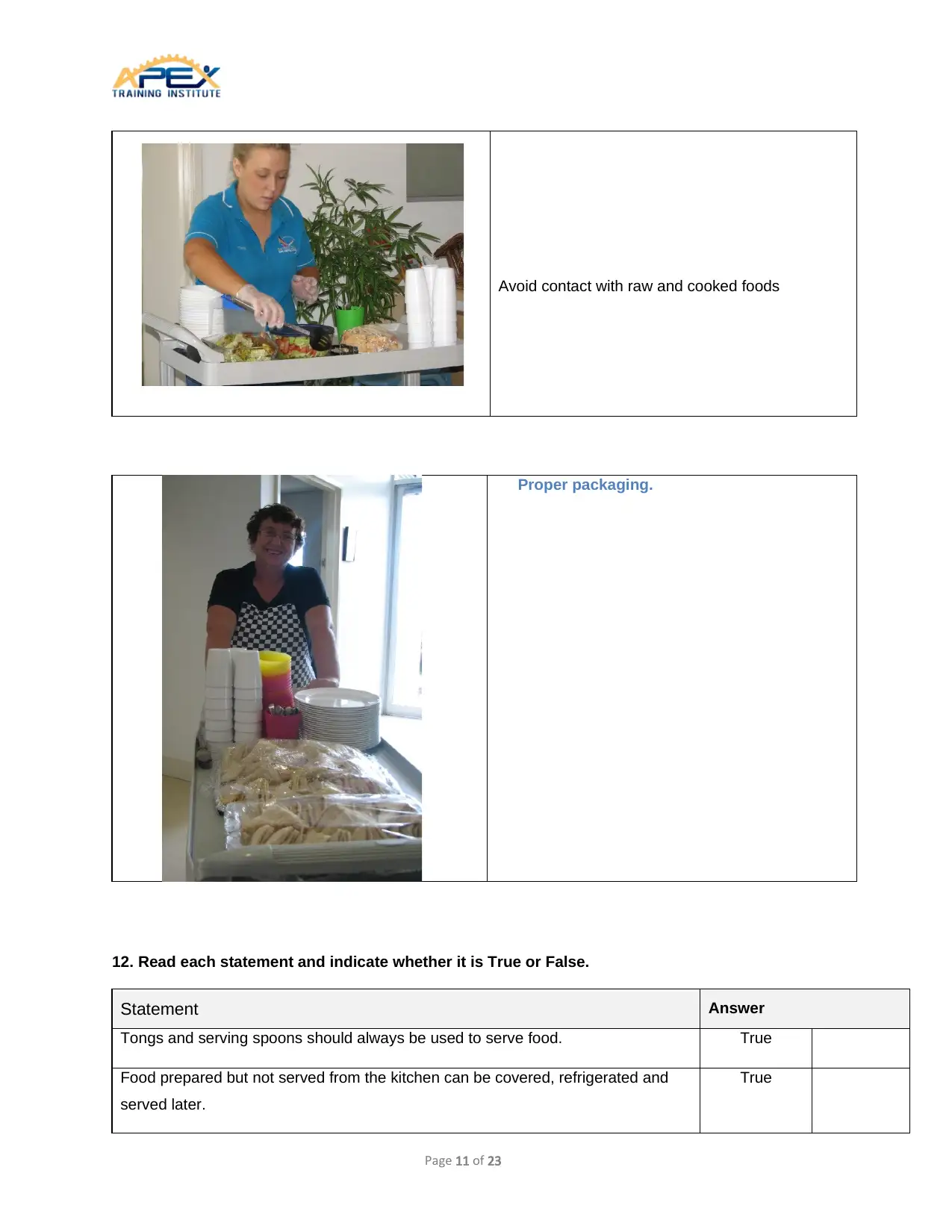
Avoid contact with raw and cooked foods
Proper packaging.
12. Read each statement and indicate whether it is True or False.
Statement Answer
Tongs and serving spoons should always be used to serve food. True
Food prepared but not served from the kitchen can be covered, refrigerated and
served later.
True
Page 11 of 23
Proper packaging.
12. Read each statement and indicate whether it is True or False.
Statement Answer
Tongs and serving spoons should always be used to serve food. True
Food prepared but not served from the kitchen can be covered, refrigerated and
served later.
True
Page 11 of 23
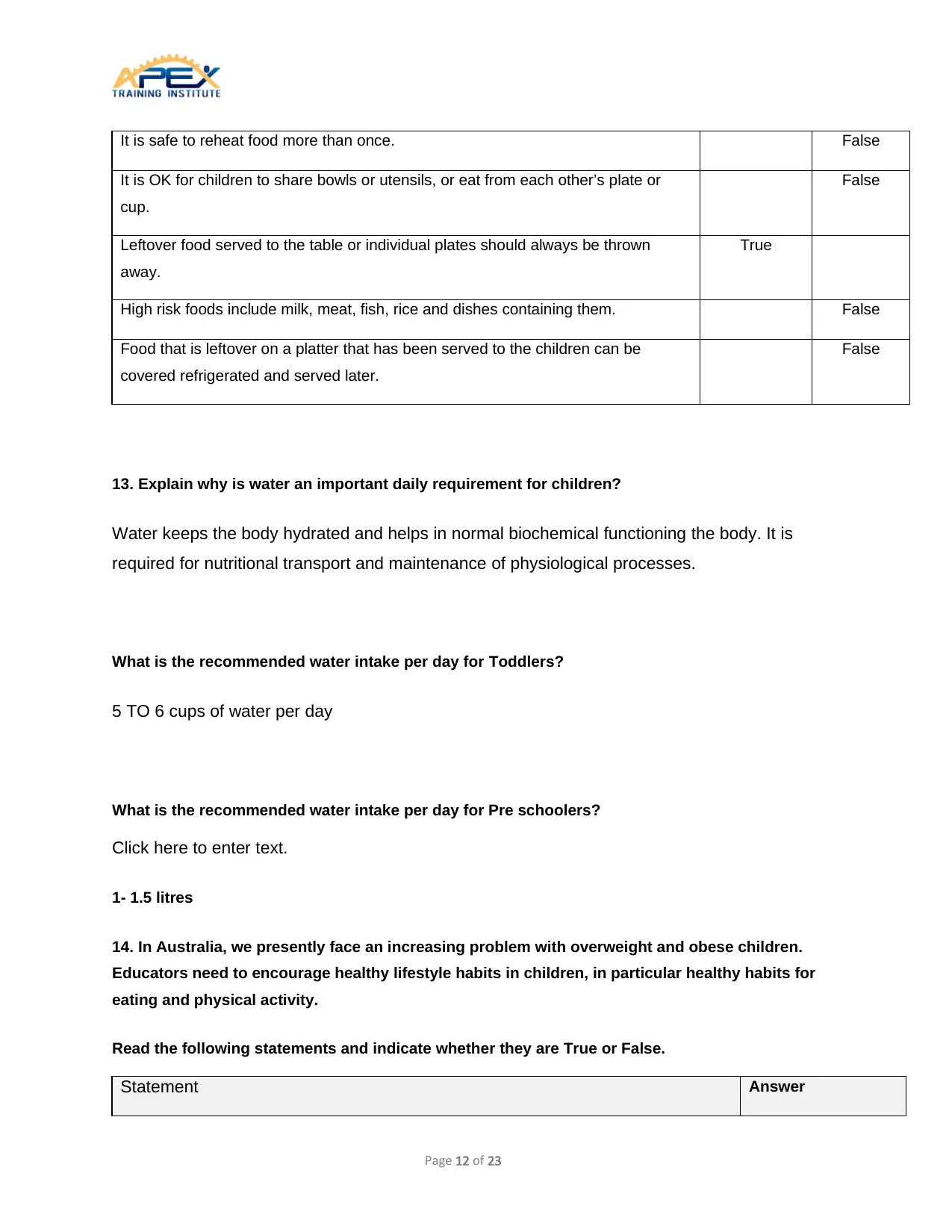
It is safe to reheat food more than once. False
It is OK for children to share bowls or utensils, or eat from each other’s plate or
cup.
False
Leftover food served to the table or individual plates should always be thrown
away.
True
High risk foods include milk, meat, fish, rice and dishes containing them. False
Food that is leftover on a platter that has been served to the children can be
covered refrigerated and served later.
False
13. Explain why is water an important daily requirement for children?
Water keeps the body hydrated and helps in normal biochemical functioning the body. It is
required for nutritional transport and maintenance of physiological processes.
What is the recommended water intake per day for Toddlers?
5 TO 6 cups of water per day
What is the recommended water intake per day for Pre schoolers?
Click here to enter text.
1- 1.5 litres
14. In Australia, we presently face an increasing problem with overweight and obese children.
Educators need to encourage healthy lifestyle habits in children, in particular healthy habits for
eating and physical activity.
Read the following statements and indicate whether they are True or False.
Statement Answer
Page 12 of 23
It is OK for children to share bowls or utensils, or eat from each other’s plate or
cup.
False
Leftover food served to the table or individual plates should always be thrown
away.
True
High risk foods include milk, meat, fish, rice and dishes containing them. False
Food that is leftover on a platter that has been served to the children can be
covered refrigerated and served later.
False
13. Explain why is water an important daily requirement for children?
Water keeps the body hydrated and helps in normal biochemical functioning the body. It is
required for nutritional transport and maintenance of physiological processes.
What is the recommended water intake per day for Toddlers?
5 TO 6 cups of water per day
What is the recommended water intake per day for Pre schoolers?
Click here to enter text.
1- 1.5 litres
14. In Australia, we presently face an increasing problem with overweight and obese children.
Educators need to encourage healthy lifestyle habits in children, in particular healthy habits for
eating and physical activity.
Read the following statements and indicate whether they are True or False.
Statement Answer
Page 12 of 23
⊘ This is a preview!⊘
Do you want full access?
Subscribe today to unlock all pages.

Trusted by 1+ million students worldwide
1 out of 23
Related Documents
Your All-in-One AI-Powered Toolkit for Academic Success.
+13062052269
info@desklib.com
Available 24*7 on WhatsApp / Email
![[object Object]](/_next/static/media/star-bottom.7253800d.svg)
Unlock your academic potential
Copyright © 2020–2025 A2Z Services. All Rights Reserved. Developed and managed by ZUCOL.





